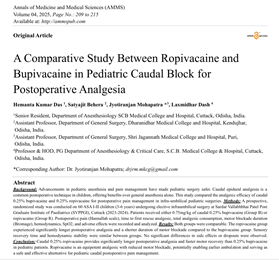A Comparative Study Between Ropivacaine and Bupivacaine in Pediatric Caudal Block for Postoperative Analgesia
Authors
##plugins.themes.bootstrap3.article.main##
Abstract
Background: Advancements in pediatric anesthesia and pain management have made pediatric surgery safer. Caudal epidural analgesia is a common postoperative technique in children, offering benefits over general anesthesia alone. This study compared the analgesic efficacy of caudal 0.25% bupivacaine and 0.25% ropivacaine for postoperative pain management in infra-umbilical pediatric surgeries. Methods: A prospective, randomized study was conducted on 60 ASA I-II children (3-6 years) undergoing elective infraumbilical surgery at Sardar Vallabhbhai Patel Post Graduate Institute of Paediatrics (SVPPGI), Cuttack (2023-2024). Patients received either 0.75mg/kg of caudal 0.25% bupivacaine (Group B) or ropivacaine (Group R). Postoperative pain (Hannallah scale), time to first rescue analgesic, total analgesic consumption, motor blockade duration (Bromage), hemodynamics, SpO2, and adverse effects were recorded and analyzed. Results: Both groups were comparable. The ropivacaine group experienced significantly longer postoperative analgesia and a shorter duration of motor blockade compared to the bupivacaine group. Sensory recovery time and hemodynamic stability were similar between groups. No significant differences in side effects or dropouts were observed. Conclusion: Caudal 0.25% ropivacaine provides significantly longer postoperative analgesia and faster motor recovery than 0.25% bupivacaine in pediatric patients. Ropivacaine is an equipotent analgesic with reduced motor blockade, potentially enabling earlier ambulation and serving as a safe and effective alternative for pediatric caudal postoperative pain management.
##plugins.themes.bootstrap3.article.details##
Copyright (c) 2025 Hemanta Kumar Das, Satyajit Behera, Jyotiranjan Mohapatra, Laxmidhar Dash

This work is licensed under a Creative Commons Attribution 4.0 International License.
Creative Commons License All articles published in Annals of Medicine and Medical Sciences are licensed under a Creative Commons Attribution 4.0 International License.
[1] Merskey H, Bogduk N. Classification of Chronic Pain. IASP Task Force on Taxonomy. IASP Press, Seattle 1994;2(2):209-14.
[2] Hurley RW, Wu CI. Acute Postopssssserative Pain. In: Miller RD, editor, Miller‘s Anaesthesia.7th ed. Elsevier: Churchill Livingstone;2010:758.
[3] Macres SM, Moore PG, Fishman SM. Acute Pain Management. In: Barash PG,Cullen BF, Stoelting RK, Cahalan MK, Stock MC, editor, Clinical Anaesthesia. 6th ed. Lippincott Williams & Wilkins; 2009:1474.
[4] American Academy of Pediatrics. Committee on Psychosocial Aspects of Child and Family Health; Task Force on Pain in Infants, Children, and Adolescents. The assessment and management of acute pain in infants, children, and adolescents. Pediatrics. 2001 Sep;108(3):793-7. doi: 10.1542/peds.108.3.793.
[5] Anand KJ, Brown MJ, Causon RC, Christofides ND, Bloom SR, Aynsley-Green A. Can the human neonate mount an endocrine and metabolic response to surgery? J Pediatr Surg. 1985 Feb;20(1):41-8. doi: 10.1016/s0022-3468(85)80390-0.
[6] Anand KJ. Pain, plasticity, and premature birth: a prescription for permanent suffering? Nat Med. 2000 Sep;6(9):971-3. doi: 10.1038/79658. PMID: 10973310.
[7] Peters JWB, Schouw R, Anand KJS, van Dijk M, Duivenvoorden HJ, Tibboel D. Does neonatal surgery lead to increased pain sensitivity in later childhood? Pain. 2005 Apr;114(3):444-454. doi: 10.1016/j.pain.2005.01.014.
[8] Gai N, Naser B, Hanley J, Peliowski A, Hayes J, Aoyama K. A practical guide to acute pain management in children. J Anesth. 2020;34(3):421-433. doi:10.1007/s00540-020-02767-x.
[9] Cummings EA, Reid GJ, Finley AG, McGrath PJ, Ritchie JA. Prevalence and source of pain in pediatric inpatients. Pain. 1996 Nov;68(1):25-31. doi: 10.1016/S0304-3959(96)03163-6.
[10] Sengupta S, Mukherji S, Sheet J, Mandal A, Swaika S. Caudal-epidural bupivacaine versus ropivacaine with fentanyl for paediatric postoperative analgesia. Anesth Essays Res. 2015;9(2):208-212. doi:10.4103/0259-1162.
[11] Giaufré E, Dalens B, Gombert A. Epidemiology and morbidity of regional anesthesia in children: a one-year prospective survey of the French-Language Society of Pediatric Anesthesiologists. Anesth Analg. 1996 Nov;83(5):904-12. doi: 10.1097/00000539-199611000-00003.
[12] Ninu, Marie & Basumatary, Dr & Saikia, Ashim & Deka, Sangeeta. (2022). A comparative study of local anaesthetics ropivacaine and bupivacaine for caudal epidural anaesthesia in children undergoing lower abdominal surgery.
[13] Kuthiala G, Chaudhary G. Ropivacaine: A review of its pharmacology and clinical use. Indian J Anaesth. 2011;55(2):104-110. doi:10.4103/0019-5049.
[14] Da Conceicao MJ, Coelho L. Caudal anaesthesia with 0.375% ropivacaine or 0.375% bupivacaine in paediatric patients. Br J Anaesth. 1998 Apr;80(4):507-8. doi: 10.1093/bja/80.4.507.
[15] Ivani G, Lampugnani E, Torre M, Calevo Maria G, DeNegri P, Borrometi F, Messeri A, Calamandrei M, Lonnqvist PA, Morton NS. Comparison of ropivacaine with bupivacaine for paediatric caudal block. Br J Anaesth. 1998 Aug;81(2):247-8. doi: 10.1093/bja/81.2.247.
[16] Pasham Abbaiah Rontala Saraiah. A Comparative Study Between Bupivacaine and Ropivacaine in Caudal Block in Paediatric Age Group (0 To 8 Years) in Unilateral Groin Surgeries.Indian J Anesth Analg.2020;7(3):659–663.doi: 10.21088/ijaa.2349.8471.7320.1.
[17] Knudsen K, Beckman Suurküla M, Blomberg S, Sjövall J, Edvardsson N. Central nervous and cardiovascular effects of i.v. infusions of ropivacaine, bupivacaine and placebo in volunteers. Br J Anaesth. 1997 May;78(5):507-14. doi: 10.1093/bja/78.5.507.
[18] Da Conceicao MJ, Coelho L, Khalil M. Ropivacaine 0.25% compared with bupivacaine 0.25% by the caudal route. Paediatr Anaesth. 1999;9(3):229-33. PMID: 10320602.
[19] Brescham C, Krumpholz R, Schaumberger F, Likar R. Ropivacaine vs. bupivacaine in pediatric caudal blocks. European Journal of Anesthesiology. 2000;17:150.
[20] Khalil S, Campos C, Farag AM, Vije H, Ritchey M, Chuang A. Caudal block in children: ropivacaine compared with bupivacaine. Anesthesiology. 1999 Nov;91(5):1279-84. doi: 10.1097/00000542-199911000-00018.
[21] De Negri P, Ivani G, Tirri T, Modano P, Reato C, Eksborg S, Lonnqvist PA. A comparison of epidural bupivacaine, levobupivacaine, and ropivacaine on postoperative analgesia and motor blockade. Anesth Analg. 2004 Jul;99(1):45-48. doi: 10.1213/01.ANE.0000120162.42025.D0.
[22] Locatelli B, Ingelmo P, Sonzogni V, Zanella A, Gatti V, Spotti A, Di Marco S, Fumagalli R. Randomized, double-blind, phase III, controlled trial comparing levobupivacaine 0.25%, ropivacaine 0.25% and bupivacaine 0.25% by the caudal route in children. Br J Anaesth. 2005 Mar;94(3):366-71. doi: 10.1093/bja/aei059.
[23] Ray M, Mondal SK, Biswas A. Caudal analgesia in paediatric patients: Comparison between bupivacaine and ropivacaine. Indian J Anaesth. 2003;474:275-8.

